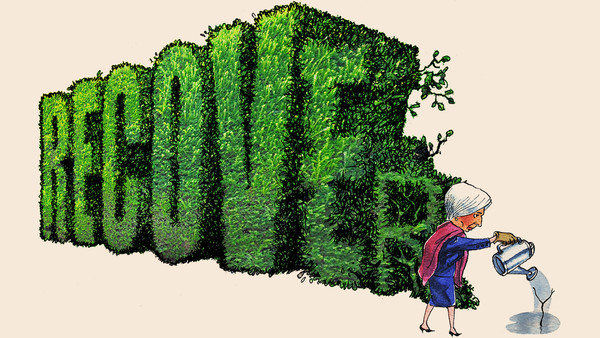Are we to believe that slower growth in the worldeconomy is here to stay? Christine Lagarde of theInternational Monetary Fund thinks so; “the newmediocre” is the managing director’s dishearteningterm for what she sees as the new normal. Theworsening forecasts published in successive issues ofthe World Economic Outlooksupport her view (seecharts). Significantly, while the performance ofhigh-income economies has been poor, especially inthe eurozone, in the medium-term it is theemerging economies whose prospects appearbleakest.
我们要相信当前世界经济增长放缓的态势将延续下去吗?国际货币基金组织(IMF)总裁克里斯蒂娜•拉加德(Christine Lagarde)是这么认为的;拉加德用令人沮丧的词语“新平庸”(new mediocre)描述她眼中的新常态。《世界经济展望报告》一期比一期悲观的预测支持了她的观点(见下图)。重要的是,尽管高收入经济体、尤其是欧元区高收入经济体表现疲软,但就中期而言,新兴经济体的前景似乎最为暗淡。

Yet disappointments need to be kept in proportion. If average annual growth of emergingeconomies were to remain over 5 per cent, their output would double every 14 years. Thiswould mean rapid increases in the standards of living of a huge proportion of humanity. Anadditional source of good cheer is that the economies of emerging Asia are expected toachieve growth of 6.5 per cent this year and 6.6 per cent in 2015. This is no small matter,since emerging Asia contains half of humanity. The IMF has made no downgrade of itsforecasts for emerging Asia since last April. In addition, the second-fastest growing region issub-Saharan Africa. Its growth is forecast to be 5.1 per cent this year and 5.8 per cent in2015. Since these two regions contain nearly all of the world’s poorest people, thisperformance is of far wider human significance than are the disappointments elsewhere.
不过也无需过度失望。如果新兴经济体年均增长率保持在5%以上,其产出值每14年就会翻一番。这意味着,全球占相当大比例的人口的生活水平将有大幅提高。另一个令人鼓舞的消息是,亚洲新兴经济体今年增速预计为6.5%,2015年为6.6%。这不是小事,因为亚洲新兴经济体的人口数量占到全球总人口的一半。自4月以来,IMF一直没有下调过其对亚洲新兴经济体的增长预期。此外,增速第二快的地区是撒哈拉以南非洲地区。该地区今年增速预计为5.1%,2015年为5.8%。由于这两大地区的赤贫人口占到全球赤贫人口总量的绝大部分,上述增速对全球人口的重要意义远超过其他地区表现疲软的影响。
The worry, however, is that the downgrades might continue into the more distant future. Onereason for believing this will not be the case is the scale of recent disappointments. TheRussian economy, for example, is stagnant. Performance of the Latin America and Caribbeaneconomies is little better, with growth forecast at 1.3 per cent this year and 2.2 per cent in2015. It is always possible for these economies to do still worse: Vladimir Putin’s embrace of ahostile relationship with the west may make that quite likely for Russia. But substantialupside potential also exists.
然而,令人担心的是,不断下调增长预测的现象可能延续到更遥远的未来。一个让人认为不会出现这种情况的理由是近期某些地区让人失望的程度。例如,俄罗斯经济陷入了停滞。拉美和加勒比地区经济体不比俄罗斯强太多,今年增长预期为1.3%,2015年为2.2%。这些经济体表现进一步恶化的可能性始终存在:弗拉基米尔•普京(Vladimir Putin)宁愿与西方保持敌对关系,很可能令俄罗斯经济变得更糟。但这些经济体也存在着不小的上行潜力。
The trouble is that the IMF’s medium-term forecasts already assume such a rebound inemerging economies. It fears that this hoped-for rebound might not occur, because of a “lackof action on structural constraints . . . , a tightening of global financial conditions, a slow pace ofrecovery in advanced economies or any combination of these factors”.
问题是,IMF的中期展望已经假定了新兴经济体会出现此等反弹。IMF担心,鉴于“未能采取行动解决结构性约束……全球金融环境收紧、发达经济体复苏缓慢,或者这些因素任何几条的组合”,预期中的反弹或许不会发生。
The IMF adds that China’s economy might suffer a bigger slowdown than now assumed. Thiswould probably be due not to a financial crisis (which should be avoided), but a failure toreplace the demand lost when unsustainable credit booms subside. This, after all, is whathappened to the high-income countries after their credit-driven growth came to a halt sevenyears or so ago.
IMF补充称,中国经济放缓可能超过现在人们所以为的程度。其原因很可能不是一场金融危机(应当可以避免),而是当不可持续的信贷繁荣退潮时,失去的需求无法得到替代。别忘了,大约7年前,当信贷驱动的增长停滞时,高收入国家便发生了此种情况。
The WEO stresses the medium-term risk s of low potential growth and “secular stagnation”in high-income economies. The former means weak growth of supply. The latter meansstructural constraints on demand, including a rapid contraction of credit in vulnerablecountries. (See chart.) A feedback relationship exists between the two: weak growth in demandsaps confidence and damps innovation and investment. When growth is expected to be slow,private consumption and investment falter. Such a spiral is to be seen in the eurozone, wherereal demand is 5 per cent below its pre-crisis peak and deflationary risks are high. Ultra-lowinflation, let alone deflation, exacerbates the burden of debt.
《世界经济展望报告》强调了高收入经济体在中期内面临潜在增长率过低和“持续停滞”的风险。前一风险意味着供给增长疲弱。后一风险意味着需求的结构性约束,包括脆弱国家信贷急剧收缩(见下图)。这两者之间存在一种反馈关系:需求增长弱会降低信心,压抑创新与投资。当增长预计会放缓时,私人消费和投资就会停滞不前。欧元区即将看到这一螺旋式下降,那里实际需求比危机前峰值低5%,通缩风险很高。通胀率超低会加剧债务负担,通缩就更不用提了。
In the US, where balance sheets are no longer so constrained and there has been at leastmodest growth since 2009, the economy might now start to accelerate. Among the otherdrivers of such growth would be cheap energy, a pick-up in investment and a recovery inhousehold formation, which has been running at about half its pre-crisis levels. This would beunlikely to produce the kind of untoward jump in inflation that would force the Fed to applythe brakes. With the world economy weakening and oil prices falling, inflation should not bea real danger. The Fed should tighten slowly — and this is unlikely to create problems foreconomies outside the US.
在美国,资产负债表不再面临极大约束,经济自2009年以来起码实现了小幅增长。如今,美国经济可能要开始加速了。其他推动增长的因素还将包括:廉价的能源、投资增加以及新家庭组建速度的回升——该速度一直处于危机前水平的大约一半。这不太可能导致通胀意外大幅上升,那种情况将迫使美联储(Fed)踩下刹车。由于世界经济疲弱、油价下跌,通胀应该不会成为重大风险。美联储应会缓缓地收紧政策——这不太可能给美国以外的经济体带来麻烦。
本文关键字: 新兴经济体的前景暗淡
 免费试听
免费试听

时长 : 29:45 主讲 : 乔迪

时长 : 44:09 主讲 : 徐宸

时长 : 21:15 主讲 : 徐宸

时长 : 21:15 主讲 : 徐宸

时长 : 44:09 主讲 : 徐宸

时长 : 29:45 主讲 : 乔迪

时长 : 15:31 主讲 : 徐新磊

时长 : 18:37 主讲 : 孔令金

时长 : 15:31 主讲 : 徐新磊
 推荐阅读
推荐阅读
第十三届全国人民代表大会第二次会议(the second session of the 13th National People& 39;s Congress)5日上午在人民大会堂开
第十三届全国人民代表大会第二次会议(the second session of the 13th National People& 39;s Congress)5日上午在人民大会堂开
第十三届全国人民代表大会第二次会议(the second session of the 13th National People& 39;s Congress)5日上午在人民大会堂开
第十三届全国人民代表大会第二次会议(the second session of the 13th National People& 39;s Congress)5日上午在人民大会堂开
第十三届全国人民代表大会第二次会议(the second session of the 13th National People& 39;s Congress)5日上午在人民大会堂开
第十三届全国人民代表大会第二次会议(the second session of the 13th National People& 39;s Congress)5日上午在人民大会堂开
第十三届全国人民代表大会第二次会议(the second session of the 13th National People& 39;s Congress)5日上午在人民大会堂开
第十三届全国人民代表大会第二次会议(the second session of the 13th National People& 39;s Congress)5日上午在人民大会堂开
第十三届全国人民代表大会第二次会议(the second session of the 13th National People& 39;s Congress)5日上午在人民大会堂开
第十三届全国人民代表大会第二次会议(the second session of the 13th National People& 39;s Congress)5日上午在人民大会堂开
